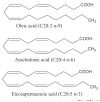Fish oil: what the prescriber needs to know
- PMID: 16542466
- PMCID: PMC1526555
- DOI: 10.1186/ar1876
Fish oil: what the prescriber needs to know
Erratum in
- Arthritis Res Ther. 2006;8(4):402
Abstract
There is a general belief among doctors, in part grounded in experience, that patients with arthritis need nonsteroidal anti-inflammatory drugs (NSAIDs). Implicit in this view is that these patients require the symptomatic relief provided by inhibiting synthesis of nociceptive prostaglandin E2, a downstream product of the enzyme cyclo-oxygenase (COX), which is inhibited by NSAIDs. However, the concept of 'safe' NSAIDs has collapsed following a multiplicity of observations establishing increased risk for cardiovascular events associated with NSAID use, especially but not uniquely with the new COX-2-selective NSAIDs. This mandates greater parsimony in the use of these agents. Fish oils contain a natural inhibitor of COX, reduce reliance on NSAIDs, and reduce cardiovascular risk through multiple mechanisms. Fish oil thus warrants consideration as a component of therapy for arthritis, especially rheumatoid arthritis, in which its symptomatic benefits are well established. A major barrier to the therapeutic use of fish oil in inflammatory diseases is ignorance of its mechanism, range of beneficial effects, safety profile, availability of suitable products, effective dose, latency of effects and instructions for administration. This review provides an evidence-based resource for doctors and patients who may choose to prescribe or take fish oil.
Figures



References
-
- Cleland LG, Gibson RA, Hawkes JS, James MJ. Comparison of cell membrane phospholipid fatty acids in five rat strains fed four test diets. Lipids. 1990;25:559–564. - PubMed
-
- Lands WEM, Libelt B, Morris A, Kramer NC, Prewitt TE, Bowen P, Schmeisser D, Davidson MH, Burns JH. Maintenance of lower proportions of (n-6) eicosanoid precursors in phospholipids of human plasma in response to added dietary (n-3) fatty acids. Biochim Biophys Acta. 1992;1180:147–162. - PubMed
-
- Cleland LG, James MJ, Neumann MA, D'Angelo M, Gibson RA. Linoleate inhibits EPA incorporation from dietary fish oil supplements in human subjects. Am J Clin Nutr. 1992;55:395–399. - PubMed
-
- Mantzioris E, James MJ, Gibson RA, Cleland LG. Dietary substitution with an a-linolenic acid-rich vegetable oil increases eicosapentaenoic acid concentrations in tissues. Am J Clin Nutr. 1994;59:1304–1309. - PubMed
-
- James MJ, Ursin VM, Cleland LG. Metabolism of stearidonic acid in human subjects: comparison with the metabolism of other n-3 fatty acids. Am J Clin Nutr. 2003;77:1140–1145. - PubMed
MeSH terms
Substances
LinkOut - more resources
Full Text Sources
Medical
Research Materials

